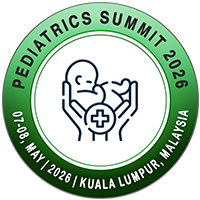
Tetiana Holovko
SI “Institute for Children and Adolescents Health Care , UkrainePresentation Title:
Comorbid conditions in children with systemic lupus erythematous
Abstract
Comorbid conditions are considered disorders (diseases) that are more common in a certain disease than in the general population and share some common etiological or pathogenetic mechanisms with it. Comorbidity increases the severity of the patient's condition and worsens the prognosis. Systemic lupus erythematosus (SLE) is an autoimmune chronic disease of unknown etiology, in which various organs and systems are involved in the pathological process. Starting in childhood or young age, the disease gradually progresses and, with ineffective treatment, leads to loss of functional ability of patients and disability. It has been proven that patients with SLE develop a number of comorbid conditions over time, which are the consequences of complicated and iatrogenic comorbidity. The purpose of the study: to establish the presence of kidneys, lungs, and blood lipid spectrum comorbid conditions in children with systemic lupus erythematosus.
Materials and methods of the study: 67 children with SLE aged 13.89 ± 0.39 years and disease duration 3.63 ± 0.41 years were examined. The following studies were conducted: to study lung function, spirometry was performed on the Spirolab III device (manufactured by Medical International Research, Italy) using the WinSpiroPRO 1.0 5.6.0 program; to study the lipid spectrum, a biochemical blood test was performed on the general-purpose automatic analyzer-photometer "CORMAY MULTI" (Poland) with determination of the level of total cholesterol (TC), triglycerides (TG), low-density lipoproteins (LDL) and atherogenic coefficient (CA); to determine kidney function, urine was examined according to the Zimnytsky method with measurement of urine density and daily protein intake, and a biochemical urine test with calculation of glomerular filtration rate (GFR). Statistical processing of the obtained data was carried out using parametric and nonparametric statistical methods using certified applied computer programs SPSS17 (license 4а180844250981ae3dae-s/nSPSS17).
Materials and methods of the study: 67 children with SLE aged 13.89 ± 0.39 years and disease duration 3.63 ± 0.41 years were examined. The following studies were conducted: to study lung function, spirometry was performed on the Spirolab III device (manufactured by Medical International Research, Italy) using the WinSpiroPRO 1.0 5.6.0 program; to study the lipid spectrum, a biochemical blood test was performed on the general-purpose automatic analyzer-photometer "CORMAY MULTI" (Poland) with determination of the level of total cholesterol (TC), triglycerides (TG), low-density lipoproteins (LDL) and atherogenic coefficient (CA); to determine kidney function, urine was examined according to the Zimnytsky method with measurement of urine density and daily protein intake, and a biochemical urine test with calculation of glomerular filtration rate (GFR). Statistical processing of the obtained data was carried out using parametric and nonparametric statistical methods using certified applied computer programs SPSS17 (license 4а180844250981ae3dae-s/nSPSS17).
Results: in the group of children with a disease duration of one to 3 years, proteinuria was registered in 68.1% of cases and in isolated cases - changes in GFR: a decrease in 4.4% and hyperfiltration - in 9.0%. In the group of children with a duration of the pathological process over 3 years, more profound changes in kidney function were detected. Thus, almost all patients had proteinuria (90.4%). The frequency of a decrease in GFR increased to 19.0%, and in 14.2% of cases a decrease in the concentration function of the kidneys was detected. When conducting spirometry, 37.5% of patients revealed a decrease in the function of external respiration of the first degree, mainly of the restrictive type. This was manifested (according to spirometry) by a decrease in the forced vital capacity of the lungs (FVC) (up to 80% of the FVC proper), while the forced expiratory volume in the first second (FEV1) and the Tiffno index (FEV1/FVC) remained within normal limits. An increase in the level of total cholesterol to (5.16 ± 0.25) mmol/l and LDL cholesterol to (2.85 ± 0.31) mmol/l was detected, which exceeded the permissible level and caused an increase in the CA to (2.21 ± 0.26). The maximum levels of proatherogenic fractions of the blood lipid spectrum were recorded in patients with high activity of SLE, and over time, against the background of treatment, their decrease to optimal values with the corresponding normalization of the CA occurred. Thus, in children with a disease duration of more than 3 years, renal dysfunction occurs not only due to the glomerular (GFR), but also due to the tubular apparatus. From the side of the external respiratory function, mild respiratory disorders of the restrictive type are formed. With a high degree of activity of the inflammatory process, hyperlipidemia is formed, which may be an early factor in the development of atherosclerosis in children with SLE.
Biography
Tetiana Holovko earned her PhD (Candidate of Medicine) in 2013 at the age of 38 from the State Institute “Institute for Children and Adolescents Health Care of the NAMS of Ukraine,” with a thesis titled "Morphofunctional state of the right ventricle of the heart and its role in the formation of chronic heart failure in children with myocardial pathology." She brings a rich and diverse professional background in pediatrics, having started her medical career as a pediatric infectious disease specialist at the Central District Hospital of Pavlograd, Dnipropetrovsk Region (1999–2000). She subsequently worked as a pediatrician in the school and preschool department of Children’s Hospital No. 5, Dnipropetrovsk (2001–2004), and then as a doctor of adolescent medicine at Children’s Polyclinic No. 23, Kharkiv (2004–2009). Between 2009 and 2012, she pursued postgraduate studies in pediatrics at the same institute where she later became a senior researcher in the Department of Rheumatology and Comorbid Conditions (2021–2022). Since September 2022, she has been serving as the Head of that department at the SI “Institute for Children and Adolescents Health Care of the NAMS of Ukraine.” In addition to her clinical responsibilities, she has been active in medical education as an Associate Professor in the Department of Pediatrics at V. N. Karazin Kharkiv National University since 2012. She holds medical licenses in Pediatrics and Pediatric Cardio rheumatology and has authored over 80 scientific publications, including 9 articles indexed in Scopus and 3 in Web of Science, with over 45 citations and an h-index of 3. She also contributes to the academic community as a peer reviewer for the American Pediatric Journal.


